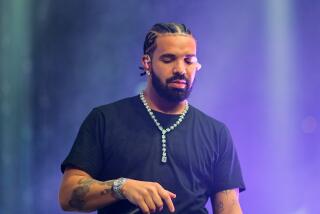Show’s Big Band Leaving on Upbeat Note
When the Johnny Carson era of “The Tonight Show” concludes Friday, and the last big band on television fades into the horizon like a glorious California sunset, a gaggle of musicians are going to be losing one of the best jobs in show business. The NBC show pays about $1,250 a week for about 15 hours of work.
But don’t worry about these guys: They aren’t going away angry, or overly sad. To paraphrase that well-worn lyric, “The show has ended, but the musicians will carry on,” according to a number of regulars with Doc Severinsen’s renowned crew.
“I think there’ll be plenty of work,” said pianist Ross Tompkins, 54, who, after stints with trumpeter Bobby Hackett and saxophonists Al Cohn and Zoot Sims, joined the show in New York in 1967, five years before it came to Burbank. “I plan on just playing jazz for now. Right after the last show I’ll be on a midnight flight to South Carolina for a jazz festival.”
“I’ll be doing more composing and arranging,” said associate conductor-saxophonist Tommy Newsom, 63, who estimated he has written more than 100 arrangements for Severinsen since joining the show in 1963.
“I’m going to work on my house, race my car, travel a bit and play some jazz,” said saxophonist Pete Christlieb, 47, a member of the band since 1972, who has had a fascination for both jazz and building drag racers since he was a teen-ager.
Many of the musicians will, in fact, keep playing with Severinsen, who signed on with NBC as a staff musician in 1949, joined “The Tonight Show” in 1962 and became its conductor in 1967. The trumpeter is taking the band out for a mostly East Coast three-week tour this summer. (At present, there is no Los Angeles date.) Engagements for next spring are also being scheduled.
“There’ll be a lot of suitcases coming out of the closet,” said Severinsen, 64, referring to the upcoming tour at a “Tonight Show” rehearsal last week.
“I wouldn’t miss it for the world,” Tompkins said of the tour.
Drummer Ed Shaughnessy, who became a member of “The Tonight Show” band in 1962, said that the musicians he has talked to share Tompkins’ enthusiasm for the three-week stint. “We’re up for it,” he said. “We want to leave a good taste for everybody. We want to leave a good echo.”
Severinsen has always been generous in granting his players liberal time off from the show, relying on a solid corps of substitutes to fill in. This attitude has allowed his musicians ample opportunity for activities outside the band--as jazz soloists, clinicians and studio players. And, with the end of the Carson era, the players said they plan to further explore those avenues.
“Now that the show’s over, I can get on with my career” as a be-bop jazz player, joked trumpeter Conte Candoli, who established himself as a major soloist with Woody Herman, Stan Kenton and Howard Rumsey’s Lighthouse All-Stars before joining Severinsen in 1972.
“No, seriously, it’s a good omen. It’ll get me off my butt and get me to places I couldn’t go” because Severinsen required that no fewer than two of the regular trumpeters be on hand for every show, said Candoli, whose latest solo album, “Sweet Simon” on Best Records, is being released at the end of the month.
Saxman Bill Perkins, 67, another 20-year “Tonight” regular who described himself as a “utility infielder” on the show--he played alto, tenor and baritone saxophones--also sees an expanded schedule as a soloist.
“I want to play more with the new Lighthouse All-Stars,” he said, referring to the nine-piece band led by veteran jazzmen Bud Shank and Shorty Rogers, of which both he and Candoli are a part.
“And I want to keep active with my small group,” said Perkins. He performs with pianist Frank Strazzeri at the Jazz Bakery on May 30--Christlieb and pianist Lou Levy are also on the bill--and leads his quartet at Jax on June 4.
Shaughnessy is one of several band members who has been working as a clinician at colleges and high schools. “I have been doing about 30 clinics a year and now I’ll be able to expand that. I’ve already been contacted about some two-week residency programs, which I couldn’t do while the show was on,” said the drummer, who also looks to tour more with his quintet and to revive his Energy Force big band.
Asked what they will miss most about the end of the show, many of the musicians, including Severinsen, cited the camaraderie of being with top-rank players on a daily basis.
“Just coming here and doing the job, that’s what I’ll miss. Standing up here in front of this band,” said Severinsen. “I’m so proud of these guys, because we’ve taken a studio band, where there can be a great deal of indifference, and turned it into an institution with its own identity.”
Others talked about the quality of the players and the challenge of having to deal with constantly shifting musical situations. “It wasn’t ‘South Pacific’ night after night,” said Shaughnessy. “Just having to learn contemporary funk music has kept me current. Plus Doc demanded that we play at a top level.”
Naturally, many players pointed out the show’s considerable financial reward.
“The show enabled me to make a living playing in a jazz band,” Perkins said.
“I’m one of the luckiest guys to have had a job like this for 20 years so I could raise my family and send my kids through school,” Christlieb said.
More to Read
The biggest entertainment stories
Get our big stories about Hollywood, film, television, music, arts, culture and more right in your inbox as soon as they publish.
You may occasionally receive promotional content from the Los Angeles Times.






